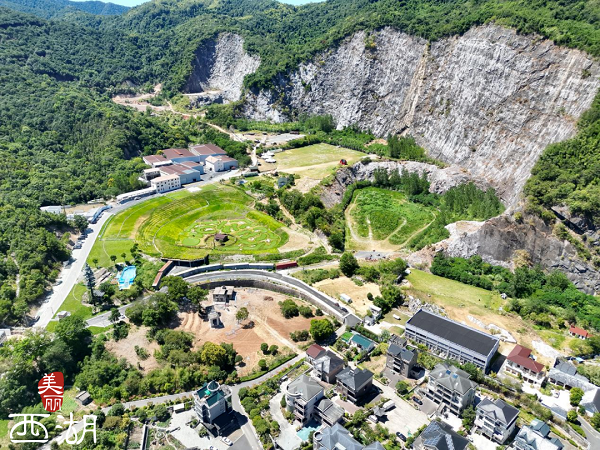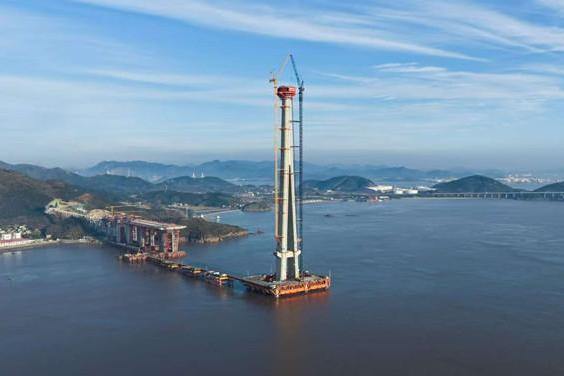
Standing on the ancient seawall in Zhejiang’s Haining city along the Qiantang River, and facing the surging tidal waves of the river, one can’t help but wonder: why Haining tidal bore? Tens of thousands of rivers are flowing into the sea on this blue planet, but why is it only in Qiangtang River that this specular scene can be found? Some clues might be discovered in “Watching the Tidal Bore on the Seventeenth Day of the Lunar Month”, a poem written by the Song (960-1279) poet Chen Shidao (1052-1102):On the endless beach, come up the tides like a white rainbow.
The nectar from the fairies’ jade cup they are, accidentally poured to this mortal world.
The blue sky is swinging in the bottom of river,
and the setting sun is bobbing in the rapid waterflow.
Imaginations aside, the Haining tidal bore goes back a long way. “On the west lies the big river, and on the east lies the great sea…when the tides surge up, they are so horrifying that they sound like thunders, and once the ships are lost in the tides, there is no way to recover them as well as the lives,” said Gou Jian (ca. 520-465 BC) in 489 BC, when the king of the State of Yue (2032-222 BC) asked one of his advisors for the possibility of military campaign on Yue’s archenemy, the neighboring State of Wu (ca. 12th century-473 BC) to the north. Back then, Goujian just returned to Yue after being imprisoned for three years in Wu. Among Goujian’s many concerns for possible defeat in his revenge, the unpredictable tidal waves weighed heavily on him, despite the fact that Yue had already been leading the way in water transport technologies and there was no difficulty in crossing the Qiantang River.
Goujian’s concern, documented in the Yuejueshu, or the Glory of Yue, is believed to be the first written record of the Qiantang River tidal bore, which is now one of the most stunning natural wonders in the world. While it is undoubtedly Haining city’s most valuable tourism resource, the tidal bore was once considered a major scourge, causing much damage.
“In 1219, the tidal waves flooded into Yanguan county [in present-day Haining] for over 20 li [10 kilometers]…destroying half of the fields along the way, the recovery of which took six years,” according to the History of Song. In 1222, a local official reported: “The county seat was originally 40 li away from the sea, but the changing water course and the tidal bore have flooded the area, with sea water now running 40 li to the south. The seawall, which was originally 20-li long, has only the middle section of about 10 li left, while the other parts are all breached and destroyed.”
In the 12th lunar month of 1324, seawater ran over the embankment and went all the way to the city walls; in the eighth lunar month of 1325, heavy winds and overflown seawater breached the embankment for over 30 li, more than 1,250 households had to relocate; and in the first lunar month of 1327, some 20 li of embankment was destroyed by the rising seawater and another 19 li was destroyed in the fourth month.
From 1403 to 1620, five major tidal disasters hit Haining, shattering houses and damaging fields, and a large number of residents had to migrate to the north. In the 23 years between 1645 and 1758, the course of the Qiantang River oscillated repeatedly along a section that was 20 kilometers wide from north to the south, which brought not only fresh destruction but also administrative redrawing between Haining and Xiaoshan.
Tides are the periodic movement of sea water caused by the combined effects of the gravitational forces of the Moon and the Sun, and the rotation of the Earth. Wherever the sea meets the land, tides can be seen.
A tidal bore, on the other hand, is a tidal surge occurring in a horn-shaped estuary or bay with a large tidal range. Theoretically, the estuaries of more than 40,000 rivers entering the sea around the world should have tidal surges. In fact, that is not the case: tidal bores can only be seen in 60 estuaries and bays in 16 countries. Among the most well-known are the Amazon River in Brazil, Hooghly River in India, River Severn in the UK and Bay of Fundy in Canada. While they all share a similar horn shape as the Qiantang River estuary, have larger tidal ranges, their tidal bores are dwarfed by the Qiantang tidal bore in terms of absolute tidal height, tidal speed and spectacle.
As the largest river in Zhejiang province, the Qiantang River runs a total length of 688 kilometers and covers an area of 55,558 square kilometers. The formation of the tidal bore results from the unique features of the Qiantang River. For one thing, its mouth is horn-shaped: at the inward side where the river mouth starts, the width stands at 19.4 kilometers while, flowing for 85 kilometers, at the outward end where it meets the Hangzhou Bay, the width increases to 98.3 kilometers. When the sea waves crash down from the East Sea into the Hangzhou Bay, the tidal energy builds up and the tidal range increases rapidly as the Qiantang River shrinks as quickly.
Although widely known as the Qiantang River tidal bore across the world, the tidal wave is called the “Haining tidal bore” by Haining people, as it is from Haining where the tidal bore starts. For example, Annals of Lin’an during the Reign of Xianchun, written in the Southern Song (1127-1279) period, put the forming of the tidal bore at somewhere near Haining’s big and small Jianshan Mountains. “…I feel justified in submitting to you the following general conclusions. At full and change of the moon the Bore of the Tsien-tang Kiang originates between X. h. and X. h. 30 m. in the neighbourhood of the meridian of Chi-san [Jianshan], a conspicuous hill 12 miles E. by S. 1/2 S. from Haining,” wrote Captain William Moore (1849-1918) in Report on the Bore of the Tsien-tang Kiang, the first detailed description of the Qiantang River bore by a Western observer. Indeed, successive surveys and investigations before the 1960s all put the area near Jianshan Mountain as the place where the tidal bore originated, before it moved eastwards to Gaoyang Mountain when extensive management and reclamation measures on Qiantang River were instituted.
While Haining has historically boasted the best watching spots for the tidal bore, visitors now can appreciate the tide even more conveniently, thanks to the construction of a “standard seawall”. Throughout centuries, Haining people have built all sorts of embankments, causeways and dams to try to tame the waves, with varying degrees of success. The founding of the People’s Republic of China has ushered in a new era of systematic governance for the Qiantang River estuary. Of particular note is the Haining Standard Seawall, running 55.66 kilometers and built between November 1996 and the end of 2005, which can withstand not only strong waves but Category 12 typhoons.
Now, rather than an affliction to be avoided, Haining tidal bore has become a veritable tourist spectacle. From the first day to the fifth day, from the 15th to the 20th day of every lunar month, when sea waves are most active, people are able to watch the tidal bore along the Standard Seawall twice, once at daytime and once at night, with a wide range of facilities and amenities provided.





